As the Philippines continues its COVID-19 vaccination drive, its active cases have spiked past 86,000, including the country’s highest single-day increase since the pandemic began. A year after lockdown was declared, the health system is, once again, overwhelmed.
While the Department of Health’s hospital referral system is swamped with calls about new cases, 30 hospitals in NCR have declared full bed capacities for COVID-19 patients. COVID-19 variants have been detected in all cities in Metro Manila, prompting the government to place the area as well as Cavite, Laguna, Rizal and Bulacan in a bubble from March 22 to April 4. Within this period, only essential travel will be allowed into and out of these places.
More than ever, faster and more efficient processes need to be in place, especially since only over 500,000 have so far been inoculated—less than 1% of the 70 million targeted to achieve herd immunity this year. To better understand this issue, we discuss key points of an online discussion held by the Women’s Business Council of the Philippines, featuring health-sector heavyweights such as Former Health Secretary Dr. Esperanza Cabral; Dr. Susan Pineda-Mercado, director of Food Systems and Resiliency at the Hawaii Institute for Public; and Dr. Tony Leachon, chairman of Kilusang Kontra-COVID.
 The Parañaque government began its vaccination of senior citizens last March 22, 2019
The Parañaque government began its vaccination of senior citizens last March 22, 2019
The Need for Vaccines
In the online talk held last February, Dr. Cabral expressed her pro-vaccination views, stating how the Centers for Disease Control and Prevention (CDC) listed vaccination as one of the 10 greatest public health achievements of the 21st century. “Vaccines have gone to develop into the most life-saving medical advancement in history,” she said.
Meanwhile, Dr. Mercado explained how the COVID-19 vaccination could protect one’s health. “You get a tiny bit of the virus, and that will stimulate the development of the antibodies. It helps you recognize the enemy because if you get natural exposure, your disease will not be moderate or even severe.”
With mass vaccination enabling majority of the population to develop a considerable degree of immunity against COVID-19, Dr. Cabral stated the following possible benefits:
- Protects us, our loved ones and communities from disease and death
- Enables us to reopen our society
- Prevents our health care workers from being overwhelmed
- Frees us up to address the non-COVID diseases we suffer from
“Why are vaccines important to us? They are important to us because if there is a vaccine for a disease, it will prevent that severe disease and death from it,” Dr. Cabral said. “It will prevent symptomatic disease and importantly, it will also prevent the transmission of disease to others.”
 Dr. Grace Pagayon-Uy received her first jab of AstraZeneca as part of the QC government’s vaccine rollout for health care workers this week.
Dr. Grace Pagayon-Uy received her first jab of AstraZeneca as part of the QC government’s vaccine rollout for health care workers this week.
The Importance of Starting Early
But as Dr. Mercado stated, mass vaccination does not guarantee an immediate victory against the virus. The changes are likely to be felt gradually, which is why early intervention is key. Dr. Cabral enumerated these results of Israel’s early vaccination drive, which started in January:
- COVID-19 vaccine was 98.9% effective in preventing deaths and hospitalizations.
- COVID-19 vaccine was 98% effective in preventing infections that prompted fever or breathing problems.
- Infection rate declined by 95.8% among those who received two doses of the vaccine.
To guarantee early vaccination, Dr. Leachon shared that acquisition of vaccines should start as early as the phase 2 of clinical trials—which is what Vietnam, China, India and South Korea did. He presented a projection of good economic growth among these countries. Meanwhile, poor pandemic response resulted in the plummeting economies of the US, Brazil and the UK.
 AstraZeneca vaccine arrive in the Philippines from the COVAX facility last March 4. (Photo from National Task Force Against COVID-19)
AstraZeneca vaccine arrive in the Philippines from the COVAX facility last March 4. (Photo from National Task Force Against COVID-19)
On the Flip Side: Anti-Vaxxers
The World Health Organization included “vaccine hesitancy” in one of the top global health threats in 2019. WHO stated, “Vaccine hesitancy – the reluctance or refusal to vaccinate despite the availability of vaccines – threatens to reverse progress made in tackling vaccine-preventable diseases. Vaccination is one of the most cost-effective ways of avoiding disease – it currently prevents 2-3 million deaths a year, and a further 1.5 million could be avoided if global coverage of vaccinations improved.”
WHO identified the possible reasons for vaccine refusal:
- Complacency
- Inconvenience in accessing vaccines
- Mistrust or lack of confidence
Throughout history, anti-vaxxers—the term used for those who oppose vaccines—have cited various side-effects from vaccines. These included infertility, brain damage, and most recently, autism, which some claimed were an effect of the MMR (measles, mumps and rubella) vaccine for children. This resulted in a decline in MMR vaccinations, which, in turn, resulted in an emergence of measles and mumps in Europe and North America, which had not seen these diseases for many years. According to the CDC, studies have dispelled the claim linking vaccinations to autism.
 Dr. Gladys Lacuna-Mendoza gets her first dose of Sinovac vaccine. According to Sec. Carlito Galvez, chief implementer of the National Task Force Against COVID-19, almost 24% of the country’s 1.7 million health workers have been vaccinated.
Dr. Gladys Lacuna-Mendoza gets her first dose of Sinovac vaccine. According to Sec. Carlito Galvez, chief implementer of the National Task Force Against COVID-19, almost 24% of the country’s 1.7 million health workers have been vaccinated.
Convincing the Skeptics
A recent survey from OCTA Research revealed that 46% of Filipinos are unwilling to get inoculated against COVID-19 even if the vaccine was proven safe and effective. To combat this massive vaccine hesitancy, Dr. Cabral urged the government to use “trustworthy and trusted talking heads, and use language that people can easily understand.” Messages should also be balanced and consistent, and widely reiterated across all platforms.
Dr. Leachon even warned that future travel might require COVID-19 immunity passports. “This is important to economic recovery and that’s why we need to have vaccination. The Philippines will be isolated from the rest of the world if we will not be vaccinated— tourists will hesitate to come, the international business people will not travel, Filipinos may not be given passes to travel abroad, thus curtailing business activities and even family leisure and travel. Our competitiveness will sink even further in the rankings.”
But even with vaccination, Leachon said health measures should still be improved such as contact tracing, quarantine and isolation facilities, and even government messaging. “We should invest in health care so we can prepare for the next pandemic. We have to take better care of our health care workers.”
Still, even if public acceptance of vaccination improves, the slow arrival and rollout of COVID-19 vaccines remain a major hindrance. All the health experts in the online discussion agreed that right now, there is no room for complacency. To save lives and the economy, vaccination needs to be a priority. “The economy will never recover as long as the virus is not controlled. And if you don’t understand that, then we’re part of the problem,” ended Dr. Leachon.
Donna Lina with Agay Llanera
With the whole world racing to beat the pandemic, COVID-19 vaccinations are at the top of the global news pile. According to Bloomberg, the United States tops the list of having the most vaccinations so far at the rate of over 2 million doses per day.
Since the start of the Philippines’ vaccination drive last March 1, the latest tally of total vaccinations is now over 114,000. Besides the delayed arrival of vaccines, another hurdle the country’s mass vaccination faces is the Filipinos’ reduced confidence in vaccines. According to a recent survey, 46% of Filipinos are unwilling to get inoculated against COVID-19 even if the vaccine was proven safe and effective.
A Brief History of Vaccines
English Physician Edward Jenner is widely recognized to have made the first vaccination in 1796. After inoculating a child with smallpox virus, the vaccinee developed an immunity to the disease. Mass immunization following the development of the smallpox vaccine led to the disease’s global extermination in 1979.
The Centers for Disease Control and Prevention (CDC) acknowledges the crucial role of childhood vaccines in preventing the following diseases:
- polio
- measles
- diphtheria
- pertussis (whooping cough)
- rubella (German measles)
- mumps
- tetanus
- rotavirus
- Haemophilus influenzae type b (Hib)
For communicable diseases, vaccines act as extra protection for the body and the entire community. To get this kind of protection, a community must achieve herd immunity.
What is Herd Immunity?
Herd immunity or population immunity is defined by the World Health Organization (WHO) as the “indirect protection from an infectious disease that happens when a population is immune either through vaccination or immunity developed through previous infection.” WHO makes it clear that it supports herd immunity against COVID-19 through vaccination.
This is achieved through mass vaccination, enabling majority of the population to be immune to the disease. Scientists are still researching how much of the population needs to be inoculated for herd immunity against COVID-19 to take place. In the Philippines, the government announced its plans to vaccinate 100% of its adult population or about 70 million Filipinos.
COVID-19 Vaccination Plan in PH
Last February, the Inter-Agency Task Force for the Management of Emerging Infectious Diseases (IATF-EID) finalized the priority list for the COVID-19 vaccination drive.
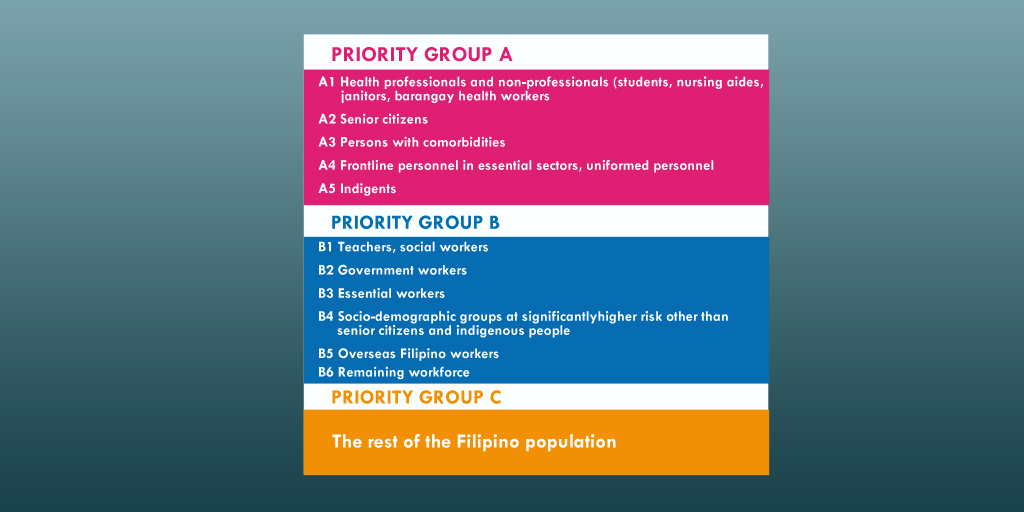 Source: Philippine News Agency (PNA)
Source: Philippine News Agency (PNA)
According to the Philippine National Deployment and Vaccination Plan for COVID-19 Vaccines, the government has accumulated ₱82.5 billion to cover costs of procuring vaccines, logistics, distribution and monitoring.
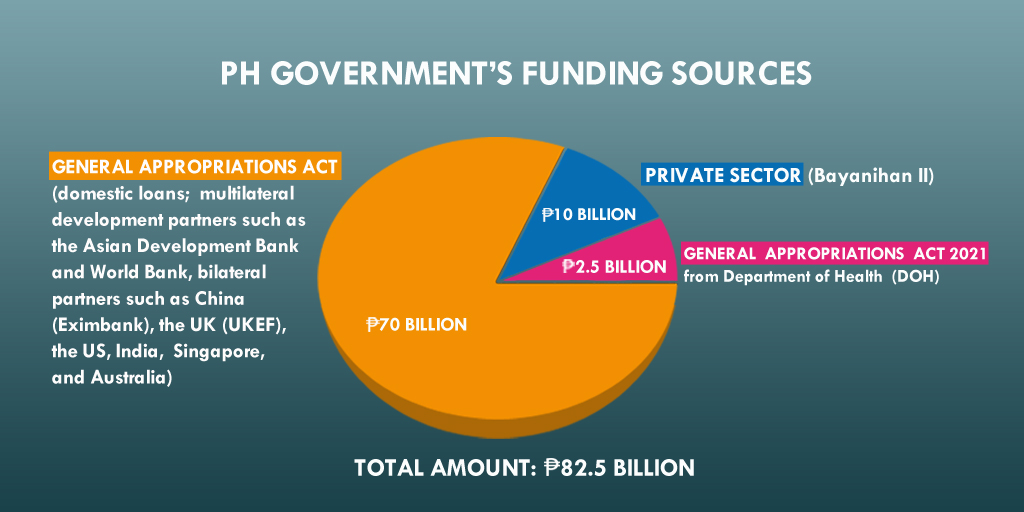 Source: DOH
Source: DOH
With vaccination costs pegged at ₱1,300 per individual according to Department of Finance (DOF) Secretary Carlos Dominguez III, around 57 million Filipinos will benefit from the nearly ₱75-billion funds allocated by the government for vaccine acquisition. The remaining individuals are to be covered by the local government units (LGUs) and the private sector. Under the Bayanihan to Recover as One Act, the national government, local government units (LGUs) and about 300 Philippine companies signed an agreement with British pharmaceutical company AstraZeneca to procure 17 million vaccine doses. In this article, Presidential Adviser for Entrepreneurship Joey Concepcion said that half of the vaccine doses will be given to the national government, while the remaining half are for the companies’ workforce.
Nationwide Vaccination Drive
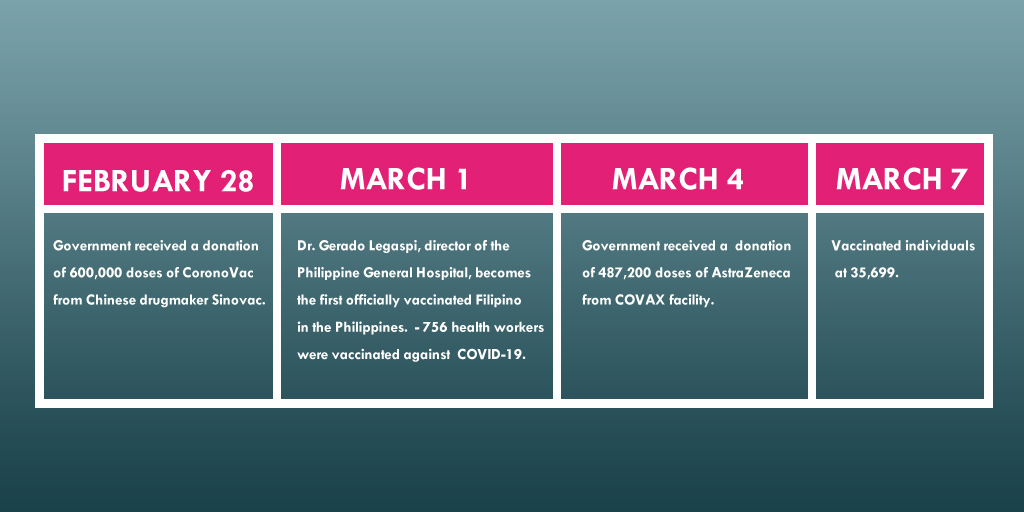 Sources: DOH, WHO, PNA
Sources: DOH, WHO, PNA
 Over 480,000 doses of AstraZeneca vaccine arrive in the Philippines from the COVAX facility. (Photo from National Task Force Against COVID-19)
Over 480,000 doses of AstraZeneca vaccine arrive in the Philippines from the COVAX facility. (Photo from National Task Force Against COVID-19)
With population projections from the Philippine Statistics Authority, the government developed a three-year vaccination plan from 2021 to 2023. The roadmap assumes that by 2022, those 16 years old and below may be allowed to take the vaccine, and that by 2023, newborns can be inoculated against COVID-19. Those who’d taken the shots in 2021 will be given booster shots in the succeeding years.
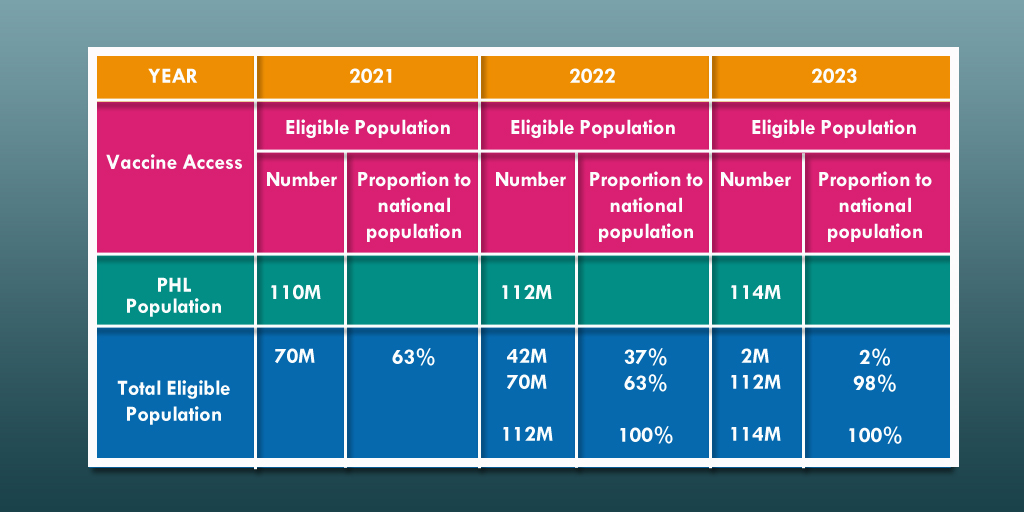 Source: DOH
Source: DOH
Achieving Herd Immunity
Though WHO emphasizes that “the proportion of the population that must be vaccinated against COVID-19 to begin inducing herd immunity is not known,” the Philippine government’s goal of vaccinating 70 million Filipinos this 2021 aims to achieve herd immunity. Because each vaccination requires two doses, 140 million vaccine doses need to be rolled out in a year.
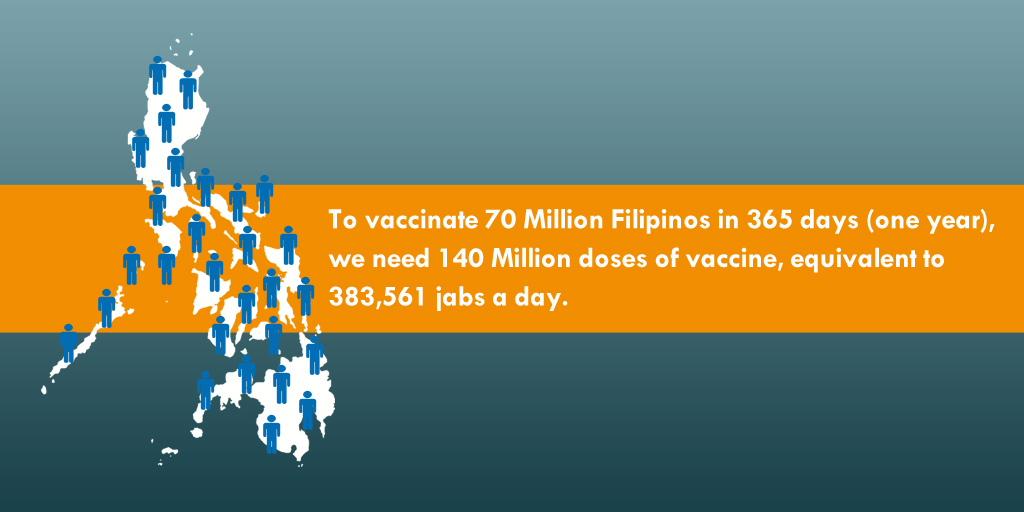
Based on such figures, the government needs to ramp up its vaccination drive to achieve herd immunity, and enable the country to recover both from the health and economic crises.
The country’s battle against the pandemic is still unfolding but one thing remains clear: until the crucial number of 70 million have not been vaccinated, Filipinos need to be on their toes as cases continue to surge.
Time is of the essence, but with majority having no means for vaccination yet, basic health and safety measures are still the strongest defense against this disease which continues to add to the global death toll of over 2 million.
